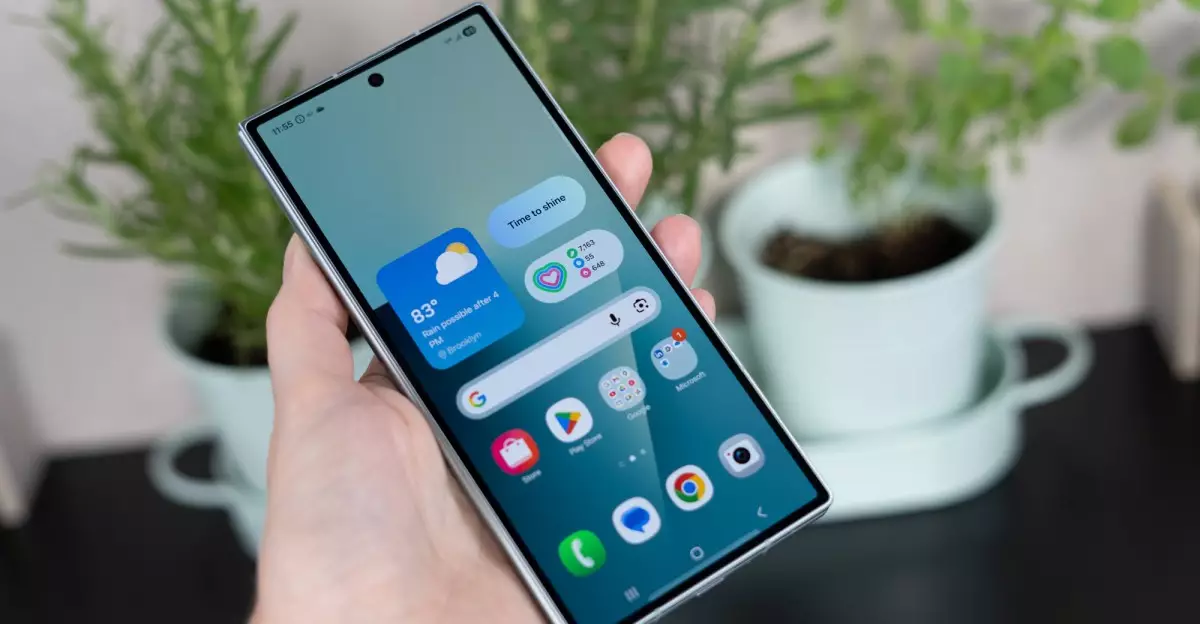The Galaxy Z Fold 7 marks a significant milestone in the evolution of foldable smartphones, positioning itself as the pinnacle of technological innovation from Samsung. Its ultra-slim design at just 8.9mm when folded epitomizes the pursuit of seamless convergence between portability and performance. Enhancing user experience, the device’s larger 6.5-inch outer display bridges the gap between a traditional phone and a foldable, making it look and feel more like a regular handset rather than a bulky futuristic gadget. Such design improvements are undeniably impressive—they set the stage for a new era of mobile devices that could ultimately replace traditional smartphones.
However, a closer look reveals that this device is not without its flaws. The improvements in form factor and screen size, while notable, do not fundamentally alter the core performance metrics inherited from its predecessor, the Galaxy Z Fold 6. It remains an expensive device, starting at nearly $2,000, which immediately raises questions about whether these incremental upgrades truly justify the hefty price tag. The sleekness and added screen real estate are appealing, but in the grand scheme, these features fall short of transforming the device into a revolutionary product. Instead, they seem like refined iterations that cater more to niche enthusiasts and early adopters than to the mainstream consumer seeking truly disruptive technology.
Preorder Incentives and the Allure of Immediate Savings
Preordering the Galaxy Z Fold 7 during the promotional window offers a tempting array of incentives—an aspect that fuels hype but also warrants skepticism. Carriers such as AT&T, Verizon, and T-Mobile are dangling substantial trade-in offers, promising up to $1,100 in credit for older models like the Galaxy S series or prior foldables. These credits are designed to slash the effective price in half, bringing the out-of-pocket cost down to around $999.99. Such savings are alluring and can be tempting for consumers eager to jump into the foldable revolution.
Nevertheless, a critical perspective uncovers hidden complexities. The trade-in processes are inconsistent across platforms; Samsung’s direct trade-in benefits are straightforward, offering instant credit, but carrier-based offers frequently involve installment plans spanning 36 months. This can mask the actual cost of ownership over time, potentially leading buyers to underestimate the true financial commitment. Moreover, the condition of the trade-in device can heavily influence value—some carriers accept phones “in any condition,” which insinuates a level of variability that could impact the final savings.
Furthermore, the promotional offers carry expiration dates—most notably, the preorder perks expire at the launch date, July 25. This creates a tight window that pressures consumers to decide quickly, often before they have fully evaluated whether the device’s benefits genuinely align with their needs. The allure of such discounts and credits might overshadow the practical considerations, such as the device’s price, ecosystem compatibility, and long-term value.
Questionable Value Proposition in an Overpriced Market
While the Galaxy Z Fold 7 exhibits a commendable leap in design and usability, it is, undeniably, an extravagance masked by technological advancement. The device’s starting price of $1,999 is a major barrier, especially considering that it offers only marginal performance improvements over its predecessor. Given that the phone’s core specifications haven’t dramatically changed, the question arises: Are consumers genuinely receiving enough value to justify such an expenditure?
This skepticism is compounded by the fact that even attractive trade-in deals and accessories credits often do little to make the purchase truly economical. For example, while Samsung provides a $50 credit toward accessories or an extra $300 if no trade-in is involved, these perks are often fleeting and limited to their official storefront. Buying through other retailers like Amazon or Best Buy might unlock better deals, such as no-cost upgrades to 512GB storage or bundled gift cards, but these options are scattered and inconsistent.
The proliferation of limited-time offers fosters a sense of urgency that may induce impulsive buying—yet, it also highlights the reality that the device’s high upfront cost remains a significant obstacle for most consumers. For a device with shallow performance gains, this level of expenditure seems more justified for tech enthusiasts or status-conscious buyers rather than the average user.
The Galaxy Z Fold 7 is a triumph of modern design, pushing forward the idea that smartphones can be both powerful and adaptable. Its ultra-slim profile, larger outer screen, and refined folding mechanics are undoubtedly impressive and represent technological progress. However, in the broader context, it remains an expensive niche product with limited tangible benefits for everyday users.
Consumers looking for a breakthrough device should approach the hype with a critical eye. The promotional discounts and trade-in incentives, while attractive, ultimately serve to mask the device’s hefty price tag and question whether the incremental gains justify the financial outlay. As it stands, the Galaxy Z Fold 7 challenges traditional notions of smartphone design—not necessarily for the betterment of all users, but for the elite whos can afford to indulge in premium, innovative gadgets that often seem more like luxury statements than indispensable tools.


Leave a Reply